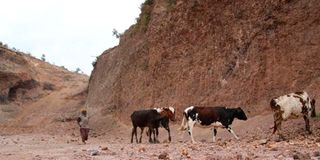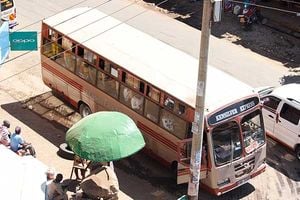Abandoned Laikipia excavation sites now 'death traps' to locals

A woman drives her cows outside an excavation site at Withare village in Laikipia county on July 19, 2022. The sites have become a death trap for livestock as well as wildlife and are life-threatening to humans.
What you need to know:
- The pit was a murram excavation site for a Chinese company that was constructing the Solio-Ngobit-Makutano highway 500 metres away.
- Investigations are still underway to establish who has been leasing public land to the construction company.
About a year ago, 56-year-old Robert Mwangi was grazing his herd of cattle near his home in Ngobit, Laikipia county when one of his cows fell and died in a borrow pit.
The pit, with a 50 feet crumbling block and a width of 100 metres at Withare location was a murram excavation site for a Chinese company that was constructing the Solio-Ngobit-Makutano highway 500 metres away.
At the time, the foreign contractors who had been building roads in the area since 2017, were finalising their work on the 50-kilometre road.
Mwangi says he approached the company’s management for compensation while accompanied by his village elder but was only offered Sh5,000 after a series of meetings with them.
This was hardly enough to compensate for the loss of his dairy cow which had a market value of Sh100,000 and would produce more than a litre of milk daily.
He resorted to reporting the matter to Ngobit police station even though the construction company has since left the country.

Robert Mwangi, a resident of Withare village in Laikipia county narrates how he lost his cow in an excavation site in the area on July 19, 2022.
Similar case
In a different incident in March this year Ms Beth Waruguru, another resident, lost her eight-month calf to the same borrow pit.
Her nine-year-old grandson was herding the cow, which was her only one when the accident happened.
“My grandson tried saving the cow by pulling it by its rope when it started sliding down the hole but when he could not keep up the pressure to hold it, he eventually let it go,” she says.
She is grateful that he let go of the rope as she would have otherwise lost them both.
Waruguru says she never reported the incident to the authorities but has since become wary of the abandoned mine which is just 500 metres from her home.
Just like her, many locals have avoided the area which they used as grazing land because of its proximity to a nearby river and a forest.
“The river is our only source of water and to access it one has to use a feeder road that is just next to the mine,” says Waruguru adding that most of the residents no longer use the road at night or send their children to the river because of the danger the excavation site poses.

Beth Waruguru, a resident of Withare village in Laikipia county arrates how she lost her cow in an excavation site at the area on July 19, 2022.
Contrary to the Mining Act of 2016 which requires a miner to restore land after use, the excavation site has neither been buck-filled nor fenced and is a deathtrap for the locals and their livestock. The area is also prone to landslides and soil erosion.
Following the exit of the construction company from the mine in February last year, locals say that they held demonstrations after the company tried to extract murram in another area within the neighbourhood.
“The proposed area was a higher risk because it was too close to homes and the construction company had not rehabilitated its former site,” explains Mwangi.
Leased land
A local who sought anonymity for fear of victimisation heaped the blame on the area chief for colluding with the construction company to start an excavation site in the locality without the community's involvement.
But Withare village chief Patrick Wachira denied allegations of leasing public land to the construction company.
He says that he has only commissioned leases of privately owned land through their owners.
“And such land parcels have since been rehabilitated by the construction company after follow-ups by the government,” he says.
The National Environment Management Authority (Nema) regulations require a construction company to apply for an Environment Impact Assessment (EIA) License before beginning any mining activities on a proposed site.
The license ought to be issued after the production of an EIA report which stipulates how excavated sites should be rehabilitated once construction is completed.
Nema is also mandated to check whether agreements between private property owners and construction companies include land reinstatement plans before the issuance of licenses.
No assessment
But documents before Nema Laikipia County Director Jackson Muturo show that the land parcel, which he says is registered as public land, has never been assessed.
“This means that the mining activity was unregulated and is therefore illegal since the government as the owner of the plot of land was not even aware,” he says.
A letter seen by Nation written by Mr Muturo to the Chinese construction company reveals that it has been on the spot for abandoning borrow pits after extraction of road construction materials in the county.
In the letter dated December 20, 2021, also copied to the Laikipia County Commissioner and county government, Mr Muturo raises concerns about 28 murram excavation sites that have not been rehabilitated.
The Nema Laikipia County boss also accuses the company of failing to apply for the EIA licenses for the sites and acquiring public land without involving the National Land Commission (NLC).

A cow grazes near an excavation site at Withare village in Laikipia county on July 19, 2022.
Of the 28 listed land plots, five of them are public parcels, two among these being church property.
In a reply to the letter by Nema, Laikipia Central Deputy County Commissioner Joshua Marete says that to the effect of the letter, the construction company has since rehabilitated five of the listed land plots per Nema standards.
Nema County Director Mr Muturo says that the organisation is facing challenges in having the construction company reinstate such abandoned borrows.
“In response to Nema’s demands, the contractors say that some of the abandoned excavated sites were left by former construction companies that they inherited the business from,” he says.
Illegal mining
Locals who have incurred losses from such abandoned sites can only move to court as Mr Muturo says mining activities carried out without licenses are deemed illegal.
According to the Laikipia National Land Commission (NLC) County Co-ordinator Grace Wairagu, investigations are still underway to establish who has been leasing public land to the construction company.
“Although currently, residents claim that there are some errant chiefs and a group of locals who have started self-help groups with an aim of selling public land are responsible for this although it is subject to confirmation,” says the NLC county boss.
According to her, most locals don't differentiate between community and public land and this has seen many of them give out land that is government-owned.
Wairagu says that in Laikipia, community land is only found in the northern region.
She says that the government sets aside public land for utilities such as trading centres, dams and schools and for a community to utilise it, it is first required to write a proposal to the county government indicating its intention before approval for use.
Chiefs are held as custodians of public land but cannot sell such properties.
“But we are currently dealing with cases of residents supposedly ‘owning’ public land which is illegal,” she says.
She adds that the illegal murram excavation activities have skyrocketed by contractors who depend on locals to locate sites instead of approaching the government.
Mr James Mwangi of the African Centre for Corrective and Preventive Action, an environmental lobby group, says that aside from refiling, the abandoned sites can be fenced off and turned into recreation facilities with bamboo nature trails or dams to make them useful to the community.
“But in order to ensure such land restorations the government including road authorities should ensure contractors implement such solutions in their proposals before they are permitted to work in the country,” he says.
To solve the issue, Laikipia County Environment Executive Peter Matunge said that the county government has formed community committees, excluding local leaders that have been tasked with protecting public land.
Efforts to reach the accused Chinese company remained futile as it did not respond to emails. A former worker revealed that the contractors have since left the country and will only be back after the elections.





